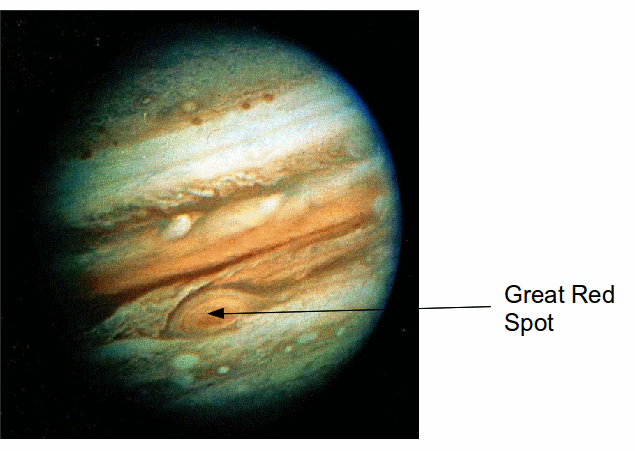Jupiter’s Great Red Spot is an atmospheric storm – three times larger than the Earth - in Jupiter's southern hemisphere that has been present for at least 400 years. Giovanni Cassini was the first to observe it in the late seventeenth century, but it was probably present before then.

About 100 years ago, the storm covered over 40,000 km 2 of the surface. It is currently about one half of that size is shrinking. It is known how long the spot will last, or whether the changes in size are a result of normal fluctuations
The spot rotates counter-clockwise and rotates one every six days but the rotation speed is increasing, possibly as a result of shrinking. At the edge of the spot the wind speed is up to 430 km/h, but at the centre the wind speeds are close to zero. Infrared data indicates that the spot is colder and about 8 km higher altitude than most of the other clouds on Jupiter. The spot is prevented from moving north and south across the planet by an eastward jetstream south of the spot and a very strong westward jetstream at the north, and the spot does not move around Jupiter at the same speed as the planet rotates. The spot has “lapped” the planet at least 10 times since the early 19th centur and the speed relative to Jupiter has changed dramatically over the years and is linked to the brightness of the South Equatorial Belt, and the presence or absence of a South Tropical Disturbance.
It is not known exactly what causes the Great Red Spot’s reddish colour. But the most popular theory is that the colour may be caused by complex organic molecules - red phosphorus or other sulphur compounds. The spot varies greatly in colour, from deep red to pink, and white. The reddest central region is about 4 K warmer than the surroundings. At times, the spot disappears from the visible spectrum and can only be seen in the infra red. The visibility of the GRS seems to coupled to the appearance of the south equatorial belt. When the south equatorial belt is bright white, the spot is dark and when the south is dark, the spot is usually light – these variations in colour are irregular.
